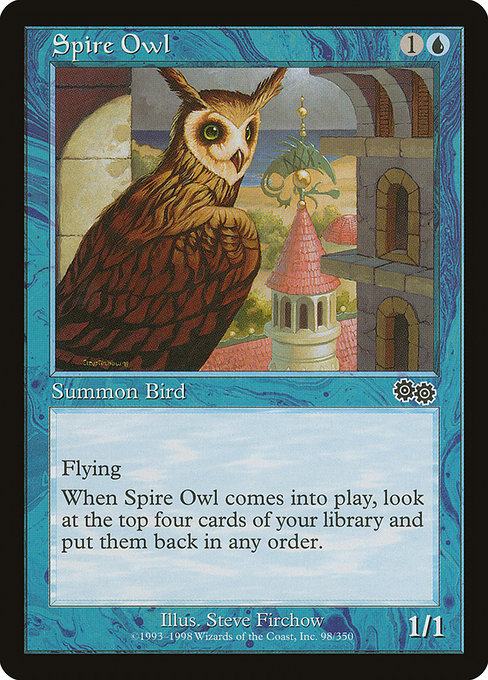
Image courtesy of Scryfall.com
Designing with Delight: Un-sets and Spire Owl as a Microcosm
If you’ve ever cracked open an Un-set and felt a grin tug at the corners of your mouth, you’re not alone. The design philosophy behind the Un-sets is a celebration of playful constraints—where truth in the rules takes a backseat to shared storytelling, surprise, and a wink to longtime players. These sets invite us to imagine how MTG could bend the usual expectations without losing the core magic that draws us to the table: the thrill of making a clever choice when it matters most. 🧙♂️🔥 The era around Urza’s Saga, meanwhile, reminded us that a single, well-timed moment of information can tilt the balance of a match. Spire Owl embodies that spirit in miniature: a blue, common creature whose enter-the-battlefield ability foregrounds knowledge as a resource, not just a card in hand. ⚔️💎
In many Un-sets, the emphasis is on humor that lands because it respects players’ expertise. You’re not just reading a card; you’re negotiating with it. Spire Owl, though not part of the Un-sets themselves, acts as a perfect bridge between design philosophies: it’s a two-mana flyer that asks you to think in terms of information architecture. When it enters, you “look at the top four cards of your library, then put them back in any order.” It’s a compact micro-lesson in planning, risk, and control—capturing that meta-magic vibe that Un-sets celebrate in a more overt, jokey way. The artful balance of freedom (you choose the order) with constraint (you can only choose from the top four) mirrors the kind of playful design conversations that fans love to revisit around dinner tables and in online threads. 🧩🎨
Spire Owl as a Case Study in Playful Information Economy
Let’s zoom in on what this two-mana blue creature actually does. With a 1/1 stat line, it’s not breaking any speed records. Its real value lies in the moment of revelation: upon entering, you get a window into the next tier of your plan. Do you order the top four cards to set up a future draw into a crucial answer, or do you juggle the top four to sculpt a more dynamic future search? The choice is yours, and that choice is the point. It’s a tactile reminder that magic is as much about what you know as what you draw. This is the sort of design that Un-set fans adore—clear, clever, and a touch cheeky about how much control we really have over a game that can feel unpredictable. 🧠💡
Artistically, Spire Owl carries a compact elegance. The blue colorway, the soaring silhouette, and the crisp, early-artwork style evoke a sense of crisp, clean decision-making. The creature’s wings feel almost like a cursor guiding your next move, a tiny symbol of how information can flutter into your hands and reshape a plan in ways that are both satisfying and fair. This is the kind of design that invites replayability: every game can feel like a fresh tutorial on how to sequence your draws, maximize your options, and respect the memory of what you’ve seen on the top of your library. 🧙♂️✨
“Rules light, but minds bright.” That’s the spirit you feel when you draft with or against cards that lean into information as a tactical resource. Spire Owl is a microcosm of that approach—a small puzzle with a big payoff when you treat top-of-library knowledge as a strategic tool rather than a mere formality.
Speaking to the broader design conversation, the Un-sets tease out the edges of what a card can do while keeping the core thrill intact: meaningful decisions that feel earned. Spire Owl demonstrates how a single, well-timed effect can turn a fragile tempo into a durable advantage, especially when you’re weaving together land drops, mana colors, and the rest of your library’s layout. The rarity being common underscores a design principle: good ideas don’t need to shout to be impactful. A quiet, well-placed mechanic can shape entire lines of play across formats, even if it’s tucked away in a card that’s easy to overlook in a glance. 🔎💎
For players crafting content around design philosophy, Spire Owl becomes a touchstone: it’s not about the most flashy ability, but about the art of letting information lead your strategy with a clean, elegant mechanic. It’s the kind of card that makes you pause, smile, and then plot your next five draws with a little more intention. The sense of possibility is contagious, and that’s the hallmark of thoughtful MTG design—whether it’s in an Un-set or a classic expansion. 🎲🧭
Practical Design Takeaways for Un-Set-Inspired Crafting
- Embrace information as a resource: Mechanics that reward peeking, sequencing, and planning align with a design ethos that values player agency and cleverness.
- Make the decision meaningful but approachable: A small creature with a big effect can anchor a playful strategy without creating overwhelming complexity.
- Pair whimsy with context: Humor lands when it resonates with established MTG ideas—like library manipulation—without trivializing the experience.
- Encourage teachable moments: Cards that reveal a clean, repeatable pattern help players learn new strategic angles without long explanations.
- Balance is kindness: Even in playful sets, fairness guides design so that clever choices can win without punishing honest misplays.
As you sketch your own playful mechanics or curate deck ideas, a calm desk setup can help you map out the next trick your cards have in store. This compact stand is a tiny reminder that great design begins with a stable surface—whether you’re stacking mana or stacking ideas. 🧙♂️🔥
More from our network
- https://blog.digital-vault.xyz/blog/post/guard-duty-tracking-long-term-value-in-older-mtg-sets/
- https://crypto-acolytes.xyz/blog/post/minecraft-villager-professions-a-beginners-guide/
- https://crypto-acolytes.xyz/blog/post/how-to-set-stop-losses-and-take-profits-for-trading-success/
- https://blog.digital-vault.xyz/blog/post/seasonal-mtg-price-trends-for-koma-and-toski-compleated/
- https://blog.digital-vault.xyz/blog/post/how-to-choose-the-right-ad-budget-for-your-campaign/